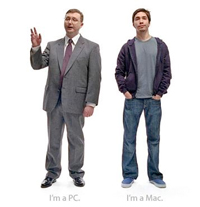 The PC market is obviously one of the huge markets for semiconductors. I think that the semiconductor content in cell-phones (in aggregate) is now greater than in PCs but I can’t find the reference I remember.
The PC market is obviously one of the huge markets for semiconductors. I think that the semiconductor content in cell-phones (in aggregate) is now greater than in PCs but I can’t find the reference I remember.
I was at Google I/O last year. One thing a friend had told me was that essentially all web development is now done on Mac. It seemed to be true. I would guess that only about 5% of the machines that I saw over those two days were Windows PCs, the rest were all Macs. Of course Apple is riding high with the iPod and the iPhone as well, it is no longer just a computer company (leading it to drop “computer” from its official name).
Steve Ballmer isn’t worried, or if he is he is trying not to show it. “Apple’s share globally cost us nothing," he said. "Now, hopefully, we will take share back from Apple, but you know, Apple still only sells about 10 million PCs, so it is a limited opportunity.” It might even be true, since a Windows license probably costs the same whatever the power of the computer.
The PC market is really a number of different markets at different price points, and Apple doesn’t play in the low end of the market. Apple has the same strategy in the phone market. Nokia is the volume leader by a long way, but a lot of that volume made up of very low-end low-margin phones. At the high end, where Apple plays, Nokia is way behind iPhone and RIM’s BlackBerry. In the consumer (as opposed to business market) iPhone is the clear leader.
But the change is starting to show up in the numbers. According to NPD, Apple has 91% market share for PCs costing over $1,000. Of course a cynic would say that’s just because Macs are so expensive, but these are the computers used by professional programmers, graphic designers and musicians. It is true that the average ASP of a Windows PC was $515 but for Mac it was $1,400. I would guess the profit is much more than 3 times as much per Mac as per PC.
So those “laptop hunters” ads have it correct. You can get a PC for much less than a Mac, but it’s not really an equivalent machine. Apple has gone from 60% of the over $1,000 market at the start of last year to that 91% number now. Last week Apple beat analysts estimates and shipped 2.7M Macs in 2nd quarter.
These numbers are retail sales, so it does ignore the PCs stronghold of large businesses that, presumably, buy through channels not classified as retail. The market seems to be splitting into two. Inside big businesses, programmers and users all use PCs and develop applications that run on top of their SAP and Oracle systems. And when it comes to cell-phones they use Blackberrys since they can be centrally administered. Outside big businesses and in internet companies, programmers and high-end users all use Macs. And when they get a cell-phone it’s an iPhone.
Microsoft announced its results too. They missed by $1B for a 17% year on year decline, and the Windows PC division declined 29%, nearly twice as bad as the overall company. Of course there’s a recession on (although Apple doesn’t seem to be noticing), and Microsoft is just on the point of shipping Windows 7, so this might eat into sales for a couple of quarters before, although it’s never been particularly cyclical in the past.
So just like Nokia’s CEO statement that iPhone is a “niche product,” Apple ships “only 10 million PCs.” But it ships all the high margin ones to the prime customer demographic. If you look at profit and not volume, you are not so keen to use words like “niche” and “only.” Especially given that high end phones become low end phones as they get cheaper, not the other way around.
